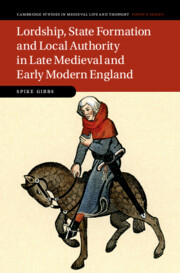Book contents
- Lordship, State Formation and Local Authority in Late Medieval and Early Modern England
- Cambridge Studies in Medieval Life and Thought Fourth Series
- Lordship, State Formation and Local Authority in Late Medieval and Early Modern England
- Copyright page
- Contents
- Figures
- Maps
- Tables
- Acknowledgements
- Abbreviations
- Introduction
- 1 The Changing Role of Manorial Officers and Manor Courts
- 2 Manorial Officeholding and Selection Processes: Participation or Restriction?
- 3 Manorial Officeholding and Unfreedom
- 4 Manorial Officeholding and Village Governance: Misconduct and Landscape Control
- 5 State Formation I: the Parish
- 6 State Formation II: Quarter Sessions, Vills and Constables
- Conclusion
- Book part
- Bibliography
- Index
- References
Bibliography
Published online by Cambridge University Press: 13 July 2023
- Lordship, State Formation and Local Authority in Late Medieval and Early Modern England
- Cambridge Studies in Medieval Life and Thought Fourth Series
- Lordship, State Formation and Local Authority in Late Medieval and Early Modern England
- Copyright page
- Contents
- Figures
- Maps
- Tables
- Acknowledgements
- Abbreviations
- Introduction
- 1 The Changing Role of Manorial Officers and Manor Courts
- 2 Manorial Officeholding and Selection Processes: Participation or Restriction?
- 3 Manorial Officeholding and Unfreedom
- 4 Manorial Officeholding and Village Governance: Misconduct and Landscape Control
- 5 State Formation I: the Parish
- 6 State Formation II: Quarter Sessions, Vills and Constables
- Conclusion
- Book part
- Bibliography
- Index
- References
Summary
- Type
- Chapter
- Information
- Lordship, State Formation and Local Authority in Late Medieval and Early Modern England , pp. 247 - 270Publisher: Cambridge University PressPrint publication year: 2023
- Creative Commons
- This content is Open Access and distributed under the terms of the Creative Commons Attribution licence CC-BY-NC 4.0 https://creativecommons.org/cclicenses/



